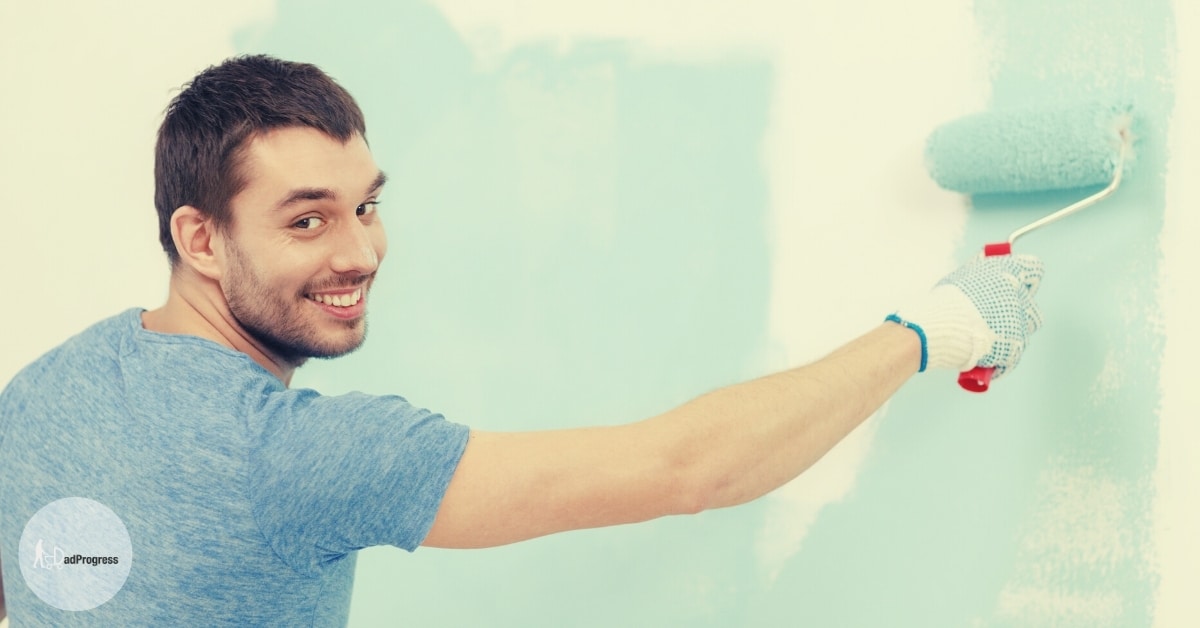Setting up a nursery is part of the excitement of having a baby on the way. It can be fun and gratifying. However, for someone who has never designed a baby’s room, it can be difficult to know where to start and what you actually need.
You can use this comprehensive guide to create a room that will be enjoyable and safe with every essential your child will need for the first year or two of life. Keep reading to learn everything you need to know about nursery design!
TIP: This site is aptly named Dadprogress because at least I’m a work in progress. If you think that one of these exceptional nursery pictures is of mine, then truth be told, I started mine too late, and it doesn’t look as cool as these examples from other dads. So TIP ONE– start early 🙂
Table of Contents
Designing a Baby Nursery First 4 Steps
On the one hand, you may have a ton of ideas in your head on what you want to add to the baby’s room. On the other hand, you may not. Use these recommendations to get your baby room design going.
1. Pick a Theme and Style
An easy way to get started with designing the baby’s room is picking a theme or style.
You can find inspiration from children’s books, cartoons, old baby prints, and novelty fabrics. You may like a Victorian style or prefer a more modern approach.
Take a bit of time to pick your theme and style because you don’t want to find a better inspiration a few months down the road.
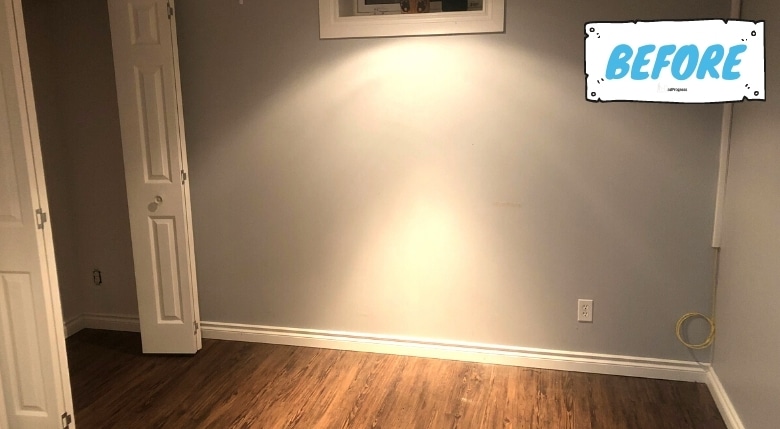

TIP: If you need inspiration then check out Pinterest. You can find millions of fresh ideas by just typing „nursery“ to the search engine.
Selecting a theme and style helps narrow down many of the other choices you will need to make during the design process.
2. Shop Textiles First
Before you buy paint, you need to find the textiles you want to use in the room. The textiles can include wall hangings, bedding, curtain/shade fabrics, throw rugs, pillows, and furniture upholstery.
Remember, it’s easier to find a paint chip that matches fabric than trying to match a particular material to a paint sample.
3. Decide on Your Color Scheme
With your theme in mind, style decided and textiles on hand; now it’s time to select your color scheme. The wall color will likely be the most dominant color in the room, so choose it with care. Soothing pastels make the baby’s room more restful.
You can also draw on lighter colors and make the nursery really stand out.

Another consideration is how often you want to repaint the room. A good paint job can last five to ten years (barring toddler intervention with crayons, paint, and markers). Going with a neutral color will help you paint less often.
Go with one or two accent colors. A child’s room often ends up being a jumble of color due to the proliferation of toys, books, and clothing. Limiting your accent colors will help them stand out amidst the chaos.
Which Colors to Pick?
It’s said that rooms start to affect us in less than 10 seconds, so it’s imperative to pick suitable colors for your nursery. All of them affect us in one way or another. Here you can see the basics of five popular colors.
When you decorate a room for an older child, take his or her temperament into account. For example, if your kid is very calm, you may want to decorate the room with little brighter energizing colors. Usually, it’s the other way around though 🙂 Calming blue color is the top choice for many parents.
Shades of Blue

Blue is generally considered one of the most soothing colors and is good for intellectual work. It’s a good idea to combine it with warmer tones though.
Shades of Green

Green promotes harmony and is good for concentration.
Pink

Pink is a soothing color, but using only pink makes the room feel draining.
White

White is a pure color, but use it too much, and the room may feel cold and unfriendly.
Orange and Yellow

These are two warm colors that are best combined with more soothing tones.
4. Consider also the Ceiling When Setting up a Nursery
In the first months of life, your infant will spend a lot of time on his or her back, looking up. Make the ceiling part of the decor. Paint the ceiling a soothing color and add a bit of interest with decals. Bring a mural up from the wall to the ceiling. Give the ceiling a starry sky.

Homedit has created a helpful post that lists 21 ideas for nursery ceilings.
Installing a ceiling fan is also a good idea for positive airflow and temperature control. A cold room makes it easier for the baby to sleep and helps to prevent SIDS.
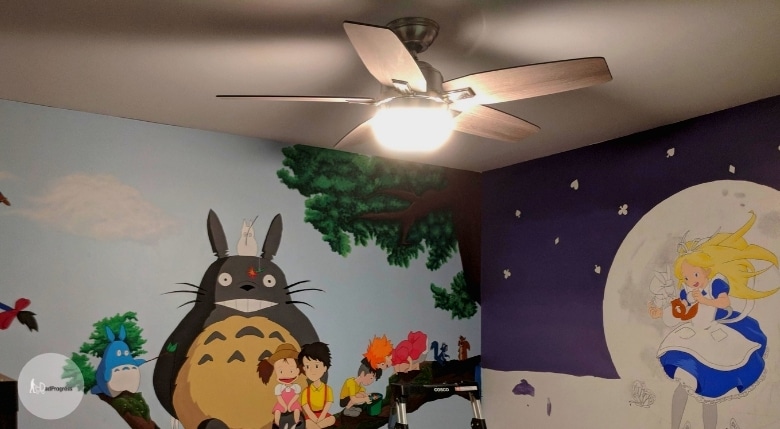
You can find many ceiling fans specially designed for nurseries. However, if you don’t want to change it out in a couple of years, a simple white one will do the trick.
Feng Shui of a Baby Bed
You can treat feng shui as simple teaching on how to make rooms more suitable for us. Two-year-olds can already often tell where they want their beds to be. It’s best to trust their instincts. But if you’re still looking for a place for a baby crib, then a couple of pointers:
- Don’t place the crib directly in front of a window because, according to feng shui, the energy flow is too intense for peaceful sleeping
- Place beds or cribs so that they face the door
- Placing many objects with sharp corners around a baby crib isn’t advisable as they can cause scary shadows
- All cribs and most toddler beds already have high headboards, which make kids feel safe
Create a Place to Nurse
Whether you are breastfeeding or using formula, you will want a place set up for feeding the baby.
Do you Need a Nursing Chair?
New parents usually buy a nursing chair (I’m no exception here), but if you’re tight on a budget or don’t have much free space, then I recommend waiting for a couple of weeks. It may turn out that you don’t miss it. For example, our boy preferred lying next to his parents while eating and so the feeding usually happened on a couch or our bed.
If you buy one, then get a comfortable, practical nursing chair with a covering that is easy to clean. Arms on the chair will help with positioning both you and the baby for a comfortable feeding, so it probably will make your life more comfortable. You can also have a table with storage within easy reach of the chair so you can have everything you need on hand.
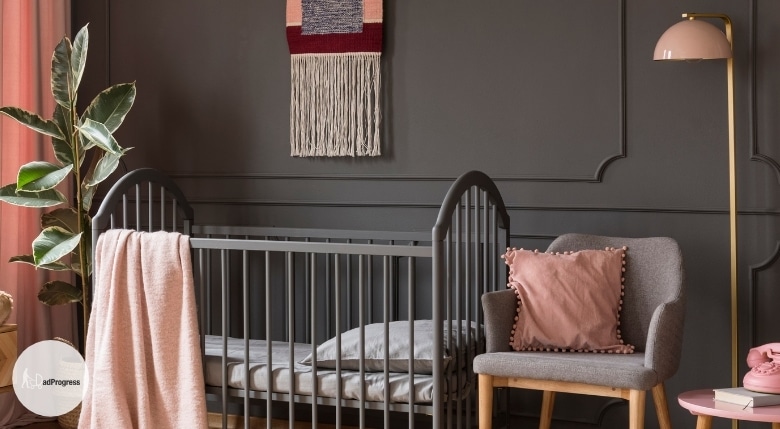
Nursing chairs may be stationary or ones that glide (click here to learn about best gliders for dads). You can’t lock a traditional rocking chair into place to prevent finger pinching as the child grows older so a glider may be a better option if you wish to buy a moving chair.
Make Your Window Coverings Functional and Beautiful
Long, long time ago in 1999 Nature published a study. It suggested that the absence of a nightly period of full darkness in early childhood may be a risk factor in the development of nearsightedness (myopia). Subsequent studies since show that it probably isn’t true. So you can safely continue using your night light. That said, if you live in a city like me, then the incoming light is quite bright, and it can cause sleep problems by reducing the amount of melatonin. Melatonin is a substance in your body that regulates your sleep rhythm.
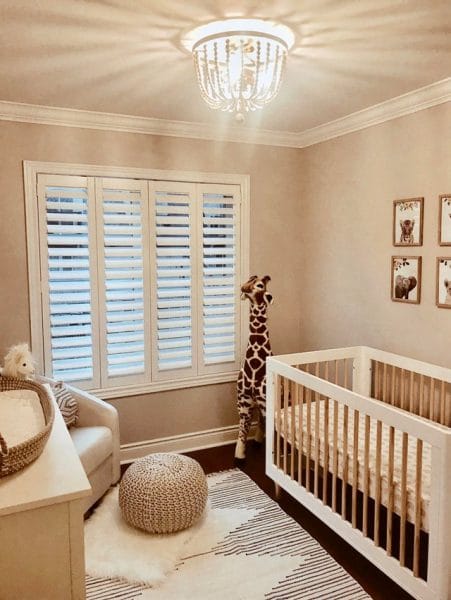
So there’s at least one good reason to install blackout curtains or shades to darken the room for the night. As a bonus, some shades reflect heat so you can keep the room cooler for your baby.
As I’ve noted before, it’s a good idea to buy the window coverings before painting, but install them after the job’s done. It’s so much easier to paint an empty room.
Choose curtains or shades that suit the theme you picked.
Baby Nursery Lighting- Give the Room Multiple Lighting Options When Setting up a Nursery
Your baby’s room should have multiple lighting options. As I’ve explained before (sorry for repeating myself), exposing your little to bright light before sleeping may cause sleeping problems.
If the room has an overhead lighting fixture, you can install a dimmer switch on it. This will allow you to adjust the light as needed.
Nighttime feedings are more comfortable if you have a second lamp next to the nursing chair. Many lamps have a dimmer switch, so you are able to adjust the light level on the second lamp. This lamp can also serve as a lamp for story time. If you have a floor lamp, then it’s a good idea to remove it after your baby starts to crawl because they are easily knocked over.
Baby Nursery Nigh Lights
Nightlights are safe to use and can comfort your older kid if he or she is afraid of the dark. At the floor level, they can be useful for safety reasons- you can see enough to avoid tripping on anything.
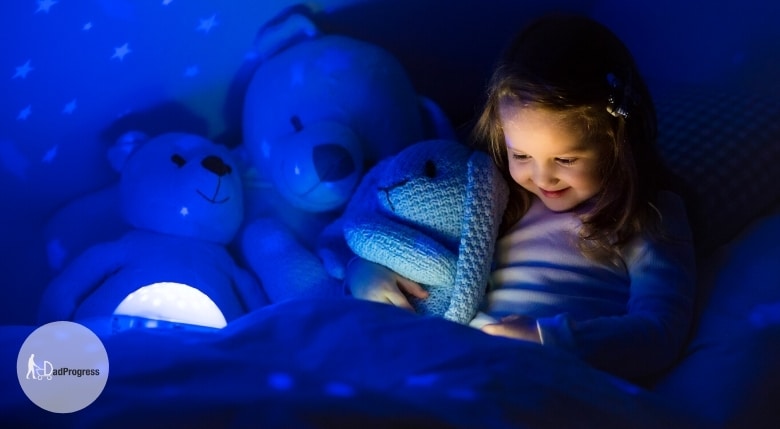
I haven’t yet bought one for my nursery because I want that my boy gets used to sleeping in the dark. Thanks to the baby monitor, I don’t have a need to go into the nursery while he’s sleeping.
Keep Sanitation Needs in Mind but Don’t Overdo it
Fear of germs or germophobia seems to be a big issue among new parents but try to get over it. Our bodies carry approximately as many bacteria as we have human cells and what’s important is the balance. If your baby is exposed to too few bacteria, it may actually be harmful to his or her. For example, the risk of allergies and some chronic diseases rises.
Keep the nursery clean, but use pure water. You rarely need harsh chemicals to clean the room.
Suggestions:
- Select your furniture with easy cleaning in mind
- All textiles should be washable
- Create a place to store cleaning supplies so you can clean up messes without leaving the room
- Know where you are going to dispose of diapers and store soiled clothing
List of 12 Nursery Essentials
If you whittle things down to the basics, you only need a crib (or a mini crib) and a mattress for a brand-new baby. However, certain items make the room more functional and practical as the baby grows.
This list of nursery essentials will help you get started:
P.S You can also print the PDF by clicking here
- Crib – The crib is where your infant is going to sleep for at least the first year. New cribs come in a wide price range. The good news is that you don’t have to buy an expensive crib to get one that meets all the required safety features. Another option is first to buy a bassinet and opt for a mini crib or a full-sized crib later on. You can see the list of 11 different crib alternatives by clicking here
- Mattress – Crib mattresses can be foam or innerspring. They can be organic or non-organic. The most two most important things are how well they fit the crib and how firm they are. The mattress must fit the crib tightly to avoid gaps where a baby could slip into. The mattress also needs to be firm to reduce the risk of suffocation. You also need a waterproof crib pad if the mattress isn’t waterproof
- Bedding – You can find crib bedding sets in so many fun patterns and themes. Unfortunately, many bedding components pose suffocation risks to infants and toddlers. Current recommendations are to remove all bedding except a fitted crib sheet (click to find the best) around the mattress and a thin waterproof mattress protector. That means no toys, pillows or thick quilts
- Dresser/Changing Table – A changing table used to be on the must list. However, a standard changing table is a single purpose piece of furniture. Many new parents now choose changing tables that easily convert to dressers later on. It is especially true in rooms with limited space
- Nursing Chair – As we’ve discussed, it’s an optional item. If you choose to buy one, pick a chair that is comfortable yet easy to get out of. You can learn more about gliders by clicking this link
- Baby Monitor – Life with an infant is a bit crazy. When the baby is sleeping, you may have to get housework done or try to catch a few Z’s yourself. A visual or audio baby monitor makes it easy to check the baby while doing other things
- Diaper Pail – Whether you go with disposables or reusable diapers, you will need a place to put them once they are soiled. A diaper pail will help corral the smell until its time to dispose of the contents or wash them
- Nightlight – Your young infant will spend a lot of time sleeping. You may need to be able to get in and out without turning on bright lights. Nightlights offer dim lighting at floor level, so you don’t trip on anything
- Clothing organization – Your newborn will only wear a few pieces of clothing at a time. However, you need to consider the organization before the baby arrives so you aren’t overwhelmed later. Babies grow very quickly so after a year you’ll have a ton of clothes, but can’t remember which of them fit at the moment (or is it just me?) A dresser is excellent for most items. Consider adding inserts to help organize things. A hanging rod might be an option if you have special occasion clothing
- Nursery rug – you don’t need to buy a rug, but it makes the room cozier, reduces noise, and can protect your expensive carpet. You can also highlight smaller objects in the room with an accent rug
- A baby bouncer (or a swing) will be indispensable because most babies stay calm there and you can get some important things done. One of the best options is the BabyBjorn bouncer
- Some parents prefer to buy a baby scale, but you don’t have to weigh a healthy full-term newborn regularly. So this item comes down to personal preference
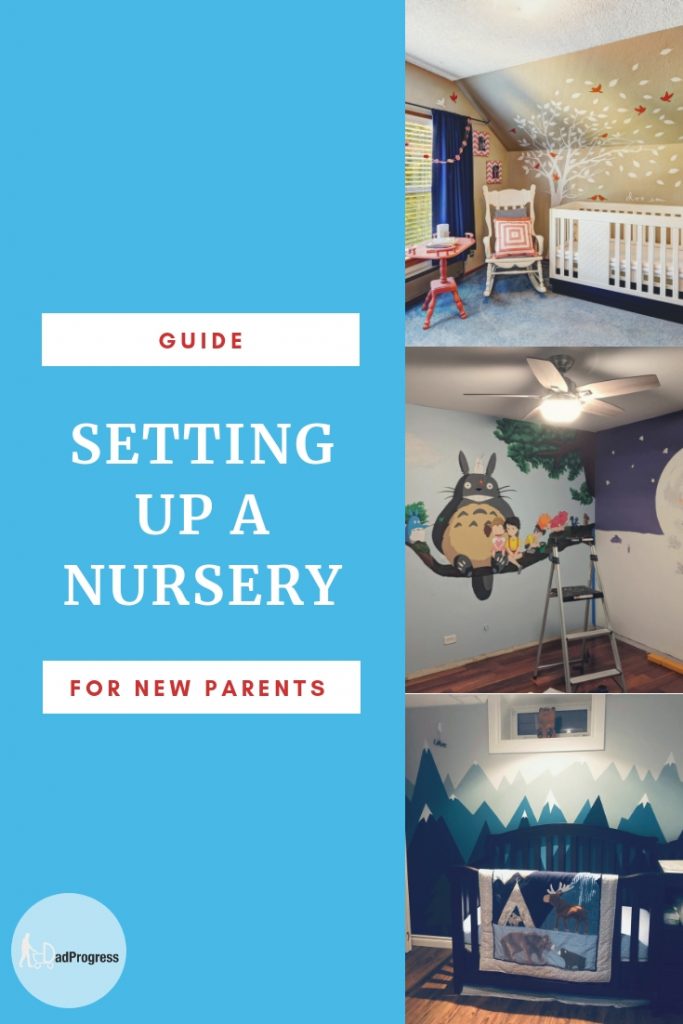
Cost of Furnishing a Baby’s Room
Today, you can spend a small fortune furnishing a baby’s room. A 2013 report in the Daily Mail stated that UK parents, on average, spend £3,825 on their babies’ rooms.
A 2017 Care.com article stated that US parents spend, on average, $2000. What is a realistic cost of furnishing a baby’s room?
It is just as easy to spend $50,000 on a baby’s room as it is to pay $1000. It all comes down to what your budget is. Buying high-end, bespoke designer furniture for the baby’s room will drive your budget well over $10,000. Buying brand new items from a big box store will land you somewhere between $500 and $1500. Adding some gently used items into the mix can easily bring down either budget.
Babyproofing Checklist
Your baby’s safety should always be a point of concern with your nursery design, especially in the room where he or she will be spending a lot of time. Babyproofing the baby’s room should start before the baby even arrives.
Use this checklist to ensure your infant’s safety:
- Make sure your crib meets the following criteria: It has fixed sides, slats are no more than two 3/8-inches apart, corner posts no more than 1/16-inch high, and mattress fitting with no gaps. All cribs made in the past few years meet these criteria
- Remove bumpers, pillows, and thick blankets from the crib. Take soft toys out also. They all pose suffocation risks for infants. The only bedding required is a fitted sheet and a thin water-proof mattress cover. On cooler evenings, dress your baby in warm clothing. There are many different opinions on when can you put pillows and blankets to the crib. I can only say that we inserted them when our boy was around eleven months old because he was motorically well developed and we assumed that he would be able to push them aside if he’d find them uncomfortable. It’s worth noting that I’m talking about a thin baby pillow here
- Keep the crib away from windows (if you live in a sunny place) and heat vents, since overheating has been associated with SIDS. Cords associated with a window blind can be dangerous when a child starts to stand and move around. So you can keep the crib away from the window or trim the cords shorter
- Anchor all tall pieces of furniture to the wall with brackets. A toddler could easily topple them over by trying to climb them
- You can put childproof locks on drawers and cabinet doors. This prevents the baby from gaining access to potentially dangerous items while also deterring climbing attempts. We didn’t do it because I couldn’t find any suitably designed locks. All the critical stuff is now in locked cupboards, but my toddler is daily taking all the things out of the unlocked drawers. So…my advice is that if you happen to find suitable locks, then insert them. It will save you a lot of time in the end
- Do not use furniture that has glass tops or insets in a nursery
- If you want to keep your toddler in the nursery, there are three options. You can lock the door. You can install a device to prevent a toddler from turning the door handle. The third option is a baby gate before the door
- Install a window guard across every window in the room. These will prevent a toddler from falling out of the window or getting outside. Installing a window stop will also prevent the window from opening more than a few inches. Avoid putting chairs or low dressers near a window to avoid a climbing risk
- Ensure window coverings are safe. Ideally, window blinds should either be cordless or have a safety device that controls cord access. Don’t install curtains that have beads or other items which could fall off and pose a choking risk. Make sure all window hardware is securely attached to the wall to prevent it from falling on a toddler
- Cover all unused electrical outlets with plastic covers. This said unless you’re an enthusiastic knitter, there probably aren’t any items lying around that your little one could manage to insert
- You may want to secure all throw rugs with non-slip pads. This will prevent slips for both you and your toddler
- Avoid bringing floor lamps into the room as they are easily knocked over. Don’t put table lamps on surfaces with tablecloths, as these are easily pulled off. Make sure the bottom of table lamps have non-slip pads installed
- Use vinyl stickers or light wall hangings. Heavy items could be dangerous if pulled off the wall
- Make sure the room has a working smoke detector
- Secure and hide electrical cords. One good yank and the corded item could become a dangerous falling object
- If your home was built before 1978, there is a chance the room may have lead paint. You can get test kits that will tell if the baby’s room has lead paint. If it does, have someone scrape the loose paint away and repaint the room
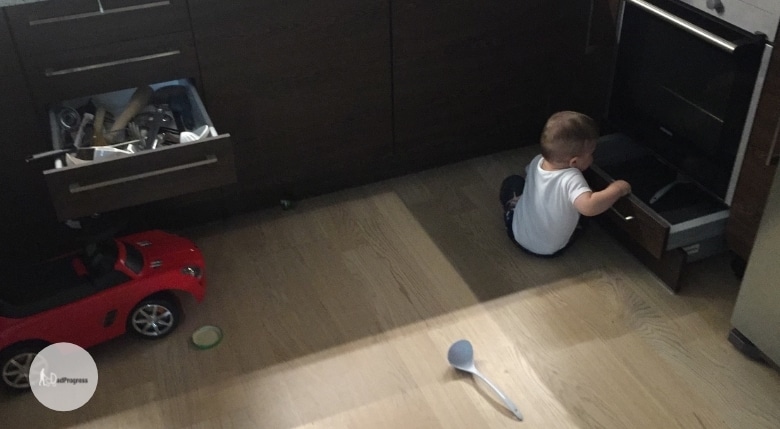
History of the Baby Nursery
The idea of having a separate bedroom for an infant started with wealthier families centuries ago. These families had the housing space to accommodate different sleeping areas for younger members of the family. They also had the money to hire staff to look after those children from birth.
A good example of this arrangement is seen in Victorian and Edwardian England. It was common for babies and young children to occupy a suite of rooms where they slept, ate, and played
Thanks for reading!

